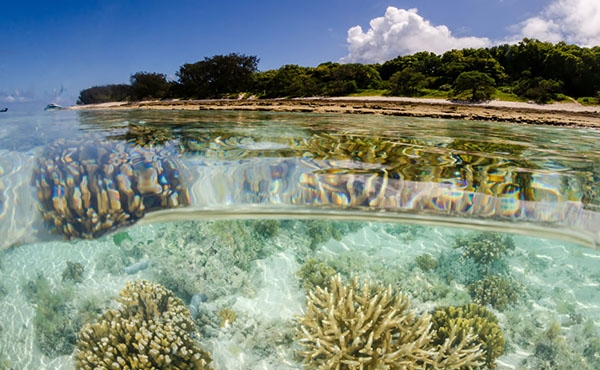34.
Wolfe, K., Kenyon, T.M., Desbiens, A., de la Motte, K. and Mumby, P.J. 2023, Hierarchical drivers of cryptic biodiversity on coral reefs, Ecological Monographs: 27
100.
Hamylton, S.M., McLean, R., Lowe, M. and Adnan, F.A.F. 2019, Ninety years of change on a low wooded island, Great Barrier Reef, Royal Society Open Science 6(6): 181314.
186.
Hopley, D. 1982, The Geomorphology of the Great Barrier Reef: Quarternary development of coral reefs, Wiley, New York.
544.
Beeden, R., Maynard, J., Puotinen, M., Marshall, P., Dryden, J., et al. 2015, Impacts and recovery from severe Tropical Cyclone Yasi on the Great Barrier Reef, PloS One 10(4): e0121272.
739.
Fabricius, K.E., Neill, C., Van Ooijen, E., Smith, J.N. and Tilbrook, B. 2020, Progressive seawater acidification on the Great Barrier Reef continental shelf, Scientific Reports 10(1): 18602.
746.
Eyre, B.D., Cyronak, T., Drupp, P., De Carlo, E.H., Sachs, J.P., et al. 2018, Coral reefs will transition to net dissolving before end of century, Science 359(6378): 908-911.
748.
Albright, R., Caldeira, L., Hosfelt, J., Kwiatkowski, L., Maclaren, J.K., et al. 2016, Reversal of ocean acidification enhances net coral reef calcification, Nature 531(7594): 362-365.
751.
Pisapia, C., Hochberg, E.J. and Carpenter, R. 2019, Multi-decadal change in reef-scale production and calcification associated with recent disturbances on a Lizard Island reef flat, Frontiers in Marine Science 6(575): 1-10.
760.
Cornwall, C.E., Comeau, S., Kornder, N.A., Perry, C.T., van Hooidonk, R., et al. 2021, Global declines in coral reef calcium carbonate production under ocean acidification and warming, Proceedings of the National Academy of Sciences 118(21): e2015265118.
776.
Szilagyi, Z., Webster, J.M., Patterson, M.A., Hips, K., Riding, R., et al. 2020, Controls on the spatio-temporal distribution of microbialite crusts on the Great Barrier Reef over the past 30,000 years, Marine Geology 429: 106312.
884.
Hopley, D. and Smithers, S. 2019, Geomorphology of coral reefs with special reference to the Great Barrier Reef, in The Great Barrier Reef: Biology, Environment and Management, eds P. Hutchings, M.J. Kingsford and O. Hoegh-Guldberg, 2nd edn, CSIRO Publishing, Clayton, Australia, pp. 9–24.
885.
Goreau, T.F. 1963, Calcium carbonate deposition by coralline algae and corals in relation to their roles as reef‐builders, Annals of the New York Academy of Sciences 109(1): 127-167.
886.
Cohen, A.L. and Holcomb, M. 2009, Why corals care about ocean acidification: uncovering the mechanism, Oceanography 22(4): 118-127.
887.
Calhoun, R.S. and Field, M.E. 2008, Sand composition and transport history on a fringing coral reef, Molokai, Hawaii, Journal of Coastal Research 24(5): 1151-1160.
888.
Nelson, C.E., Wegley Kelly, L. and Haas, A.F. 2023, Microbial interactions with dissolved organic matter are central to coral reef ecosystem function and resilience, Annual Review of Marine Science 15: 431-460.
889.
Braga, J.C., Puga-Bernabéu, Á, Heindel, K., Patterson, M.A., Birgel, D., et al. 2019, Microbialites in last glacial maximum and deglacial reefs of the Great Barrier Reef (IODP Expedition 325, NE Australia), Palaeogeography, Palaeoclimatology, Palaeoecology 514: 1–17.
890.
Riding, R., Liang, L. and Braga, J.C. 2014, Millennial‐scale ocean acidification and late Quaternary decline of cryptic bacterial crusts in tropical reefs, Geobiology 12(5): 387-405.
891.
Mallela, J. and Fox, R.J. 2018, The role of parrotfishes in the destruction and construction of coral reefs, in Biology of parrotfishes, eds A.S. Hoey and R.M. Bonaldo, CRC Press, Boca Raton, pp. 161-196.
892.
Kenyon, T.M., Doropoulos, C., Wolfe, K., Webb, G.E., Dove, S., et al. 2023, Coral rubble dynamics in the Anthropocene and implications for reef recovery, Limnology and Oceanography 68(1): 110-147.
893.
Glynn, P.W. and Manzello, D.P. 2015, Bioerosion and Coral Reef Growth: A Dynamic Balance, in Coral Reefs in the Anthropocene, ed. C. Birkeland, Springer, Dordrecht, pp. 67–96.
894.
Hill, T.S. and Hoogenboom, M.O. 2022, The indirect effects of ocean acidification on corals and coral communities, Coral Reefs 41(6): 1557-1583.
895.
Dove, S.G., Brown, K.T., Van Den Heuvel, A., Chai, A. and Hoegh-Guldberg, O. 2020, Ocean warming and acidification uncouple calcification from calcifier biomass which accelerates coral reef decline, Communications Earth & Environment 1(1): 55.
896.
Falkowski, P.G., Dubinsky, Z., Muscatine, L. and Porter, J.W. 1984, Light and the bioenergetics of a symbiotic coral, Bioscience 34(11): 705-709.
897.
Gattuso, J., Frankignoulle, M., Bourge, I., Romaine, S. and Buddemeier, R.W. 1998, Effect of calcium carbonate saturation of seawater on coral calcification, Global and Planetary Change 18(1-2): 37-46.
898.
McMahon, A., Santos, I.R., Schulz, K.G., Scott, A., Silverman, J., et al. 2019, Coral reef calcification and production after the 2016 bleaching event at Lizard Island, Great Barrier Reef, Journal of Geophysical Research: Oceans 124(6): 4003-4016.
899.
Davis, K.L., McMahon, A., Kelaher, B., Shaw, E. and Santos, I.R. 2019, Fifty years of sporadic coral reef calcification estimates at One Tree Island, Great Barrier Reef: Is it enough to imply long term trends? Frontiers in Marine Science 6: 282.
900.
Bellwood, D.R., Brandl, S.J., McWilliam, M., Streit, R.P., Yan, H.F., et al. 2024, Studying functions on coral reefs: past perspectives, current conundrums, and future potential, Coral Reefs: 1-17.
901.
Roff, G. 2020, Reef accretion and coral growth rates are decoupled in Holocene reef frameworks, Marine Geology 419: 106065.


